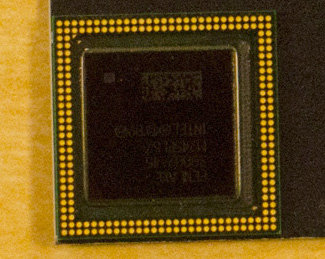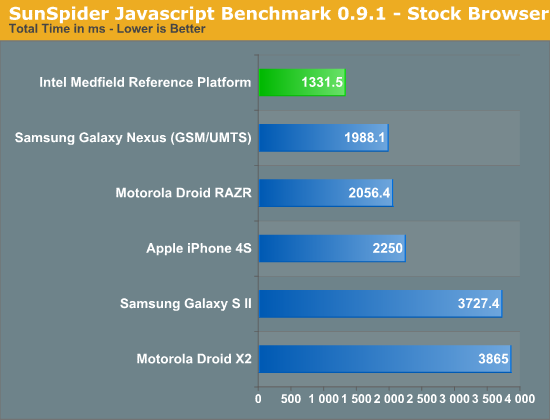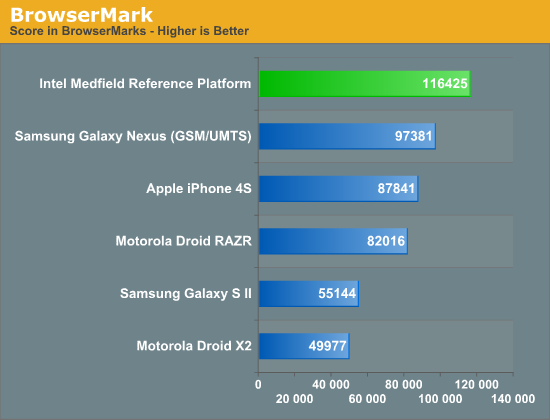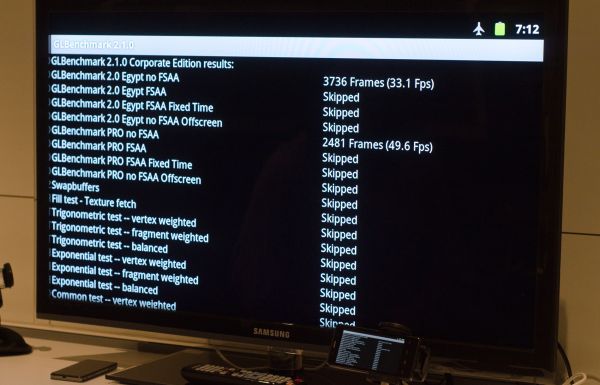Intel's Medfield & Atom Z2460 Arrive for Smartphones: It's Finally Here
by Anand Lal Shimpi on January 10, 2012 8:00 PM ESTIt's here. Intel's first smartphone SoC that you'll actually be able to buy in a device before the end of the year. The platform is called Medfield and Paul Otellini just announced its first device partners.
Medfield starts out as a bonafide mobile SoC. Whereas Moorestown was a "two-chip" solution, Medfield is just one - the Penwell SoC:

The SoC is only available in a PoP (Package on Package) configuration measuring 12mm x 12mm. Intel wouldn't give out a die size but it did show me a Penwell sample without the stacked DRAM:

Since I know the measurements of the package I could estimate the dimensions of the silicon itself. My math worked out to be around 62mm^2. That's larger than a Tegra 2-class SoC, but smaller than Tegra 3 or Apple's A5. The diagram of its high level architecture above helps explain why.
There's only a single version of Medfield being announced today: the Intel Atom Z2460. The Z2460 features a single Atom core with a 512KB L2 cache, a PowerVR SGX 540 GPU and a dual-channel LPDDR2 memory interface. In a world where talking about four Cortex A9s and PowerVR SGX 544MP2s isn't uncommon, Medfield starts out almost sounding a bit...tame. But then you see its performance:

Although running what appears to be a stock Gingerbread browser, Intel's Medfield reference platform posts SunSpider performance better than any other smartphone we've tested - including the Galaxy Nexus running Ice Cream Sandwich. Intel promises that Medfield's performance will scale on ICS as well - the gap should be maintained. We've seen high results from reference designs in the past, but the Medfield platform is a little different as you'll soon see - it's a complete smartphone design that should be representative of handsets that hit the market later this year.
Medfield isn't a one trick pony either, performance is similarly dominating under BrowserMark:

These are tablet-like scores. Here the Galaxy Nexus running ICS comes close, but once again Intel expects that on the same OS Medfield should be faster than any of the currently available SoCs.
I asked Intel where its SunSpider and BrowserMark performance advantages came from, especially considering we've typically only seen huge gains with new browsers and not new SoCs. Their response pointed to a bunch of factors, but one stand out issue was the A9 has a great execution core but seems to be more limited on the memory interface. Atom can support far more outstanding misses in L2 than the Cortex A9, which chokes bandwidth to the processor for anything not already in the L2 cache. This may be one of the reasons why we've never been able to get really high bandwidth numbers out of A9 based SoCs. It's probably safe to assume that things will be different with the Cortex A15, but for now it's little things like this that give Medfield a performance advantage.
GPU performance is understandably not as impressive. We couldn't get offscreen numbers of GLBenchmark 2.1 but we did get results at the device's native resolution (1024 x 600):
3D performance is better than the OMAP 4460 due to Medfield's 400MHz GPU clock compared to ~300MHz in most OMAP4 devices.
Performance without power considerations is meaningless, especially in the smartphone world. Luckily for Intel, Medfield seems very competitive there as well. Intel provided some power and performance data for Medfield based on its reference platform. I still haven't been able to verify any of this for myself, but I was able to see some power tests run in person on the reference platform and competitive devices.
The Intel provided values are pretty astonishing . Sub 20mW idle, sub 750mW during a call on 3G and although not pictured here, Intel's internal data suggests ~1W power consumption while browsing the web compared to ~1.3W on the iPhone 4S and Galaxy S 2. I've done my own measurements on 4S web browsing and came up with a very similar value.
| Intel Measured Smartphone Power Consumption (Identical Display Brightness) | ||||||
| Standby (3G) | Talk (3G) | Browsing (3G) | Video Playback 720p | |||
| Apple iPhone 4S | ~38mW | ~800mW | ~1.3W | ~500mW | ||
| Intel Medfield Reference | ~18mW | ~700mW | ~1.0W | ~850mW | ||
| Samsung Galaxy S II | ~19mW | ~675mW | ~1.2W | ~650mW | ||
The performance and power data both look great for Medfield. You would think that this data, assuming there's nothing fundamentally wrong, would be enough to convince a handset maker to actually give Intel a shot. You'd be right.
In addition to disclosing Medfield performance data, Intel is also announcing partnerships with both Motorola and Lenovo. The former is a broad, multi-year agreement stating that Motorola plans on creating many devices based on Intel silicon - the first of which will be a smartphone due out before the end of the year. Tablets will follow at some point as well.
Lenovo on the other hand will actually be taking and tweaking Intel's own Medfield reference platform, and releasing it in China in Q2.
All of this is exactly what Intel needed: a start.











164 Comments
View All Comments
extide - Wednesday, January 11, 2012 - link
Why does clockspeed matter? People should stop focusing on the clock so much. The real performance metric is performance per watt. Anyone remember the P4? How about Bulldozer? If intel can get more clockspeed in the same thermal envelope, then good job and they should be able to compare them side by side. I know ARM vendors would clock their chips faster, but then they run into thermal limitations.Wilco1 - Wednesday, January 11, 2012 - link
For single-threaded benchmarks clockspeed is the only thing that matters. I agree performance per watt is far more important in the real world. This is why dual or quad cores give better performance per watt than a single high clocked core. I don't believe ARM cores are thermally limited, Tegra 3 has 4 cores at 1.3GHz, and even faster SoCs are coming soon.milli - Thursday, January 12, 2012 - link
"For single-threaded benchmarks clockspeed is the only thing that matters"Ever heard of issue-width or instruction re-ordering? Ever heard of MIPS/Mhz? If you have, how can you say such a thing?
Wilco1 - Thursday, January 12, 2012 - link
IPC matters of course but only at similar frequencies. And frequency differences are typically much larger than IPC differences. For example 2-way out-of-order execution gives around 25% better IPC than 2-way in-order, however the frequency difference in the article is 33-60%. So given a large enough difference in frequency, you would expect an in-order to beat out-of-order.milli - Thursday, January 12, 2012 - link
You can't just paste performance numbers on a cpu based on it's high level architecture. Your example might be right for cpu A & B but you can't apply it just to every cpu.Next you'll tell me that a Cortex A15 is as fast clock for clock as a Phenom just because they are both 3-wide OoO architectures? Rest assured that a K10.5 core will be more than double as fast as an A15 (and i'm sure, up to 5-6x faster).
french toast - Thursday, January 12, 2012 - link
I can tell you now that cortex a15 wont be a million miles off clock for clock,even if it doesn't beat it.Obviously cache sizes/latency as well as bandwidth will play a part, but cortex a15 will be competitive with phenom, on a tiny fraction of the die space and power consumption.
cortex-a9 is nearly on par with a ULV core 2 duo clock for clock as difficult as that seems.
milli - Thursday, January 12, 2012 - link
Oh french toast, I've seen your comments here before. You just crack me up. Such a fanboi. I didn't even know there was such a thing as an ARM fanboi but you prove me wrong.FYI, an ULV C2D is around 3 to 10x faster than an A9 (clock for clock) and an A15 will get nowhere near a Phenom. Sorry to burst your bubble.
kaiyao - Wednesday, January 11, 2012 - link
While this chip for phones is finally out, does anyone know if Intel going to release any tablet chips anytime soon? Perhaps a dual/quad core version of this chip?Because Intel should really push out a chip competitive with ARM when Windows 8 comes out. I imagine if the chip performs as well as an ARM (in terms of performance and power efficiency), and if Intel matches the pricing of ARM chips, Windows 8 tablet manufacturers would definitely choose x86 over ARM to advertise compatibility with legacy applications.
I remember that the previous "mobile chip" from Intel did not work with Windows 7 due to something along the lines of the lack of PCI bus support, but since Microsoft can port Windows 8 to ARM, clearly this PCI bus is not an issue (if Microsoft modifies Win8 a bit). I presume application code will not be affected by the presence of the PCI bus.
guilmon19 - Wednesday, January 11, 2012 - link
I read somewhere, sorry i don't have a link, that intel was going to release a dual core version by the final quarterMumrik - Wednesday, January 11, 2012 - link
Page 4: "and I wouldn't be surprised if more aren't on the way."Isn't that the opposite of what you meant Anand?